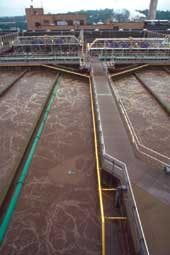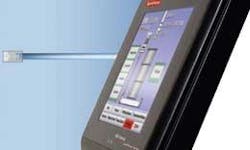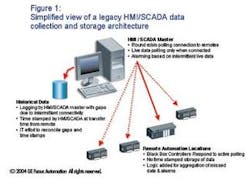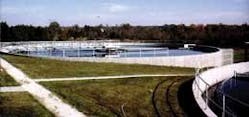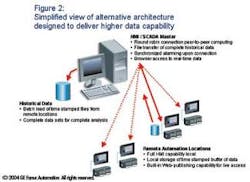By Glenn Graney
Because water treatment usually involves a large geographic area, automation systems for water/wastewater applications often require remote sites. In industrial water treatment, water is typically treated immediately adjacent to its points of use, but these locations may be across large industrial complexes. To deliver optimum results, remote automation locations must be either tightly coordinated or at a minimum monitored, which has presented some challenges in the past with regard to real-time data and event evaluation. Advances in automation technology, however, have provided alternatives to traditional approaches to managing these remote sites – and helped users speed implementation, reduce costs, improve data integrity and resulting treatment processes, and significantly ease accessibility.
Can You Hear Me Now?
Human Machine Interface (HMI) and Supervisory Control and Data Acquisition (SCADA) systems continue to be the primary technologies to support remote site management. These software solutions inherently provide a number of strong capabilities in terms of off-the-shelf visualization tools and integrated alarming capability. Still, traditional HMI/SCADA applications are all based on a central location gathering data on-line from control locations (see Figure 1). All of the valuable tools are based on near real-time or live data from the control locations.
This technology is deployed with access to all remote automation locations being defined in terms of slaves or servers of data to the HMI/SCADA system. The HMI/SCADA system acts as the master or client for the data internal to the remote automation location. The architecture is designed around the HMI/SCADA master having exclusive responsibility to gather data from the remote locations as well as to provide this valuable data to historical archives.
The logistics and/or cost of providing a permanent on-line connection between the HMI/SCADA system and remote locations can be prohibitive. This most often results in a coordinated intermittent data-gathering scheme. Remote locations are typically polled at managed intervals via round-robin phone techniques or intermittent wireless connections.
By definition, this results in gaps of non-connectivity between the central location and remote locations. There often is a large amount of engineering resources put into accounting for these gaps. Extra calculations in the controller are often performed to create averages and other statistics around process parameters. Significant data reconciliation is often necessary, since the HMI/SCADA then timestamps this collected data. This timestamp reflects the collection time not the time corresponding to the data.
Under this same discrepancy in timing, the HMI/SCADA system evaluates parameters to determine if any current or aggregated value exceeds an alarm threshold. It's actually likely that alarms happened during periods of non-connection. Intermittent alarm conditions can be missed. This time lag in evaluation can result in a recorded alarm record with a time-stamp that will be skewed from the actual alarm occurrence.
Going Remote
Automation at the remote location is first and foremost designed to meet local control and monitoring needs of the application. These remote locations are typically manned only sporadically and thus must be autonomous. Access to the data from these remote automation locations has become more critical to the greater system and has influenced technology deployed to meet these challenges.
Controller capability has moved beyond the "black box" era. Although these remote locations may be manned only occasionally, there's a need to provide complete operator interface capability. Whether it's a remote pumping station or one of many chemical delivery units inside a larger plant, operators will expect to interact with the process when they need to. This will involve complete access to current values of process parameters, any alarm instances, and the ability to perform set-points and take action.
Rather than using a separate operator interface device connected to a dedicated controller, users have begun to deploy industrial computers with integrated control based on a standard computing technology. These units based on the Microsoft CE Operating System combine the best of the PC with the hardened form factor of the PLC. These devices are very flexible and include a configurable touch screen interface that allows for customization to the application. The local application will provide a complete visualization and alarming solution that's tightly integrated into the control logic resident on the same device. These devices are Ethernet centric even if remotely located and can provide inherent web-publishing capabilities that become an integral part of the overall solution.
No Loop-Polls
The advent of standard computing technology to these remote automation locations has an impact on how designers are creating the architecture for the overall system (see Figure 2). These CE-based controllers have access to standard low-cost memory capability and thus have the capacity to store larger amounts of recorded data local to the application. These controllers typically have a resident storage capacity in the range of 32 MG and Compact flash expansion port for additional storage. At a minimum, this data can be used to provide the local operator with insights into longer periods of process history for evaluation and action.
This expanded local storage allows for more raw data to be captured and stored in standard formats. This data can be time-stamped at the time of collection for the clearest and simplest way of labeling the data. There's no manipulation of the data necessary to compact it or artificially aggregate it.
The polling sequence from the centralized HMI/ SCADA system can be designed to be a connectivity sequence rather than a polling sequence. The central system can establish a connection to the remote automation location that isn't intended to pass the "current" value of process parameters. Instead, the centralized system uses standard computing capability to copy the raw data files that completely describe the disconnected period in the absolute best terms. The data is then loaded into a central historian, which provides a comprehensive history of all aspects of the system.
The centralized HMI/SCADA system won't be required to poll the memory map of the local controller. Alternatively, the central system will synchronize alarm and event databases to allow for the passage of locally time-stamped alarms to the central system. These alarms will reflect the actual timestamp of the alarm condition, and no alarms or events will be missed due to the intermittent connections.
Finally, users at the central location can access the same screens that are local to the application. The CE-based device publishes the graphic screens and can be accessed through standard web browsers such as Microsoft Internet Explorer or Netscape. This allows for the optimum insight into local operating conditions without pre-configuration of access or excess coordination of central and remote setup.
Better Data, Lower Costs
The simple change in the access of remote automation locations delivers significant benefits to both large and small systems. The data integrity is better and the data inherently more valuable for evaluation due to the collection of complete data sets. Access to real-time status and action can be executed on demand from standard browsers with no intermediate technology. And finally, systems can be deployed more swiftly and effectively by reducing engineering around the intermittent live connection.
About the Author:
Glenn Graney is the water wastewater business manager for GE Fanuc Automation in Charlottesville, VA. He has more than 20 years of engineering and leadership experience in advanced automation and information systems, supporting a wide variety of automation and business applications. His industry experience includes water treatment, continuous processing, batch control, automotive systems, and a variety of discrete control applications. He has both a bachelor's and master's degree in industrial engineering from Penn State University. For more information, please visit www.gefanuc.com/water or contact the author at: [email protected].

